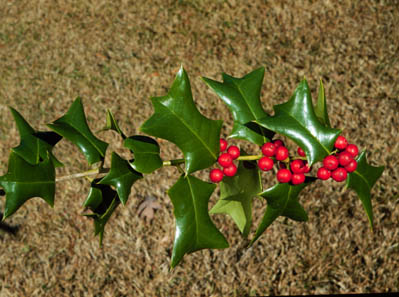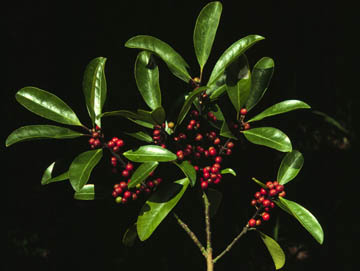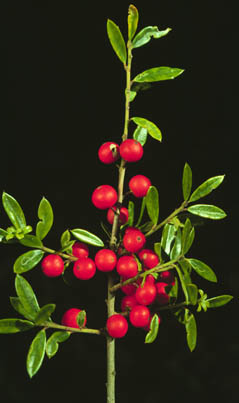
COMMONLY KNOWN AS HOLLY, DAHOON, INKBERRY, WINTERBERRY, LARGE GALLBERRY
CREATED BY:
THANG TRUNG THAI

Ilex cornuta

Ilex cassine

Ilex myrtifolia
The Holly family consists of "shrubs or trees (the trees mostly rather small), evergreen or less often deciduous, with unilacunar or sometimes trilacunar nodes, sometimes saponiferous and sometimes producing purine or pyridine base alkaloids, tanniferous or not, sometimes accumilating proanthocyanins but not ellagic acid, only seldom cyanogenic, and without iridoid compounds; clustered and sometimes also solitary crystals of calcium oxalate present in some cells of the parenchymatous tissues; vessel-segments with more or less oblique, scalariform perforations, commonly with numerous cross-bars; imperforate tracheary elements with evidently bordered pits, often septate; wood-rays heterocellular, mixed uniseriate and pluriseriate, the latter (2-) 5-15 (-25) cells wide, with elongated or (Phelline) short ends; wood-parenchyma diffuse or diffuse-in-aggregates, or (Phelline) scanty-paratracheal." ref1
Leaves are "simple, alternate or rarely opposite, sometimes (as in Phelline) in well spaced pseudowhorls; epidermis commonly mucilaginous; stomates of diverse types; mesophyll and parenchymatous tissues of the stem commonly containing resinferous and laticiferous idioblasts, the contents of which are the "fat bodies" of the older literature; stipules very small and often caducous, or wanting."ref1
Flowers are "in small, axillary, cymose inflorescences or (Phelline) in axillary racemes or panicles or mixed panicles, or (Sphenostemon) in terminal or subterminal racemes or sometimes solitary and axillary, in any case small, regular, and hypogynous, generally unisexual (the plants dioecious) but in Sphenostemon and ssp. Of Ilex sometimes perfect, 4-merous or less often 5-6-merous, seldom 7-8-merous; sepals small, imbricate, typically more or less connate at the base but distinct and caducous in Sphenstemon, in Nemopanthus wanting fron the pistallate flowers and caducous in the staminate flowers; petals shortly connate at the base in Ilex, distinct in other genera, imbricate or (Phelline) valvate, or rarely wanting; stamens usually as many asand alternate with the petals, commonly adnate to the base of the corolla in Ilex, sometimes more numerous than the petals in polycarpous speciesof Ilex, and up to 12 (but still apparently uniseriate) in Sphenostemon; anthers tetrasporangiate and generally dithecal, opening by longitudinal slits, but in Sphenostemon the stamens more or less laminar, each with 4 embedded microsporangia; pollen-grains binucleate, 3-4 colporate or -porate, or inaperturate; nactary-disk wanting; gynoecium of (2-) 4-6 (-8 or even 24) carpels united to form a compound, superior ovary with as many locules as carpels; style terminal and short, or wanting, the stigma lobed or capitate; ovules solitary (2) in each locule, apical-axile, pendulous, apotropous, anatropous to sometimes (Phelline) hemitropous or somewhat campylotropous, unitegmic, crassinucellar or sometimes tenuinucellar, with an integumentary tapetum, the funiculus often with a ventral protuberance that may represent a suppressed second ovule; endusperm-development cellular."ref1
"Fruit drupe with usually as many stones as carpels; seeds with very small, dicotyledonous embryo near the micropyle; endosperm abundant, oily and proteinaceous, without starch. X= 9,10. (Phellineaceae, Sphenostemonaceae)"ref1
Evergreen Species
"Evergreen hollies are identified by first-year twigs under 3 mm across, fresh twigs lacking a bitter-almond odor when broken, vigorous twigs with one leaf at end (stubby lateral twigs may have clustered leaves), pith continuous; by tiny stipules that have sharp dark points (these most likely to be observed at junction of current and previous year's twigs, both terminal and lateral ones); by foliage not aromatic when crushed, the underside of leaves lacking scales and yellowish glands. Flowers small, solitary orin clusters from leaf axils, usually of one sex, the sexes on separate plants, or rarely the same. Petals white to greenish-white, 4 or uncommonly 5-6. Stamens of same number as petals, sometimes present and sterile in the female flowers. Fruits glbose or nearly so, berrylike drupes with pulp bitter in most species, with 2-8 bony I-seeded stones."ref2
|
|
|
Note: This list contains only some of the approximate 400 spcies in the genus Ilex. For a complete listing of all the species of the genus Ilex refer to Index Kewensis and Gray Index.
1. Leaves with coarse spiny teeth on margin, rarely all leaves entire, at least some
leaves with spiny tips 2 2
2. Leaves oval to elliptic or elliptic-obovate 1. I. opaca
2. Leaves rectangular-oblong 2. I. cornuta
1. Leaves serrate, crenate, or entire, without coarse spiny teeth on margin or tip 3
3. Leaves crenate along most or all of the margin, sometimes minutely so
3. I. vomitoria
3. Leaves serrate or entire 4 4
4. Fruits black, stones smooth on the rounded side; leaves mostly less than twice
as long as wide, lateral veins evident on the underside 4. I. coriacea
4. Fruits red or yellow, stones with 1 groove or a few ribs on the
rounded side; leaves mostly more than twice as long as wide, main lateral
veins on underside obscure 5
5. Leaves 3-10 cm long, 3-30 mm wide 5. I. cassine
5. Leaves 1-4 cm long, 3-7 mm wide 6. I. myrtifolia
1. American Holly
Ilex opaca
Recognized by coarse stiff spines on the margin and tip of leaves, uncommonly eith spine only on the tip or even some tips spineless; by blades oval to elliptic or elliptic-oblong. Trees to 30 m tall by 80 cm DBH. Flowers about 6 mm across, the male in clusters from leaf axils, sexes on separate trees, the male in clusters of 3-12, the female soliary or in groups of 2 or 3. Fruits red or orange, rarely yellow, 7-12 mm long, stones 5-6 mm long. Often used as an ornamental, a number of varieties having been developed. Wood whitish, of fine texture, used for such things as carvings and cabinetwork; fruits eaten by wildlife. Common. With mixed hardwoods, ocasionally with pines; floodplains to upland sited. To about 1500 m elevation in Appalachians. Mar-june.
3. Yaupon; Cassena
Ilex vomitoria
Recognized by leaves crenate along most or all of the margin. The crenate aspect may be scarcely detectable on small leaves of plants in especially poor habitats. Shrubs ot trees to 14 m tall by 40 cn DBH, sprouting from the roots and tending to form thickets, usually branching near the ground. Leaves leathery, 1-4 cm long, shiny green above. Flowers about 5 mm across, in short clusters from leaf axils, usually unisexual, the sexes on separate trees, the male in dense groups, the females solitary or in groups of 2-3. Fruits 4-7 mm across, dull to shiny red, rarely yellow, with 4 narrow stones 3-4 mm long. Often used as ornamentals, as specimen plants, or trimmed into hedges. Wildlife eat the fuits and beer browse the twigs and foliage. Indians, who used the leaves for tea, transplanted the species to the new campsites, and some inland populations are probably a result of their introductions. Common. Dune areas, maritime woods, pond margind, swamps, thin upland woods, fencerows. Rarely over 150 m elevation. Mar-May.
Note: For additional identifications of other species see Trees of the Southeastern United States, Landscape Plants of the Southeast, The Oxford encyclopedia of Trees of the World, Handbook of Hollies, and The Wise Garden Encyclopedia.
There are about 400 species of hollies found worldwide. The only temperate or tropical regions lacking hollies are of the western North America and southern Australia. They are mostly evergreens but some are deciduous. Plant form varies from low, spreading shrubs to medium- sized trees. Adaptability is equally diverse, from requiring hot, dry, sandy, fast-draining soil to tolerating relatively wet heavy, poorly drainded clay. Although most hollies grow best in full sunlight, some do well in partial shade. Most members of the genus are highly tolerant of a wide range of growing conditions. But, typically, hollies perform best in a fertile moist, well-drained soil that is slightly acid and full sunlight. Their white wood is tough. The evergreens are exceptionally hardy attractive trees and shrubs for temperate climates, the European and Asiatics are adaptable to most soil and sites, while the North Americans generally prefer a neutral or acid soil. ref7,10
Hollies are mostly associated to Christmas. "The use of holly at Christmas traces to the Roman Saturnalia. During that December festivity it was the custom to send gifts accompanied by branches of the ever green to friends and others held in esteem. Much religious significance and folklore associated with holly stem from the beliefs of the acient Britons whose Druids or priests more than 2000 years ago held the tree sacred and decorated habitations with it. Some believe the word itself to be a form of "holy," but this is not certain. Besides supplying Christmas decorations, Ilex serves mankind in other ways, most importantly as mate, a stimulating tea prepared from leaves of yerba mate (I. paraguariensis) and other species widely used and greatly esteemed throughout much of south South America. In various parts of the world the leaves of fifty or more species of holly are or have been used to make beverages. American Indians employed those of the yaupon in their black drink or cassena ceremony. To participate they journeyed sometimes hundreds of miles in the spring to coastal areas where the tree grew plentifully. The brew, made by parching and boiling the leaves, was drunk in quantities sufficient to induce heavy sweating and sometimes vomiting. Only brave participated." ref4